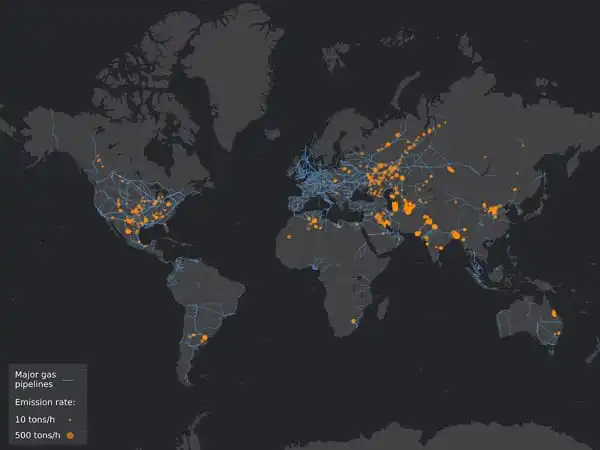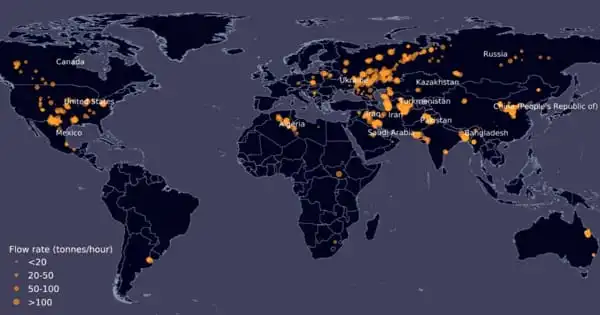Scientists have quantified massive methane emissions caused by fossil-fuel extraction activities and their impact on the climate for the first time on a global scale using satellite imagery. Their findings help to explain why official inventories of these emissions tend to be understated. Stopping these releases, whether unintentional or intentional, would save the responsible countries billions of dollars.
Oil and gas producers who can demonstrate that they are taking aggressive steps to reduce methane emissions can credibly argue that their resources should be prioritized over higher-emission alternatives. It is critical for the oil and gas industry to be proactive in limiting the environmental impact of oil and gas supply in any way possible, and for policymakers to recognize this as a critical component of global energy transitions.
An international study led by CNRS and CEA researchers, as well as the company Kayrros, uncovered hundreds of major methane leaks associated with global oil and gas extraction activities. The scientists demonstrated that limiting the amount of carbon released would both mitigate climate effects and save money – billions of dollars for the major fossil-fuel-producing countries. Their study is published in Science.
Methane (CH4), a major contributor to climate change, has a global warming potential approximately 30 times greater than CO2 over a 100-year period. One-quarter of all anthropogenic emissions of this greenhouse gas come from the global extraction of coal, oil, and natural gas (of which methane is the main component). A 2018 study found that official US inventories significantly understated actual emissions from oil and gas extraction and distribution activities. The observed disparity appears to be the result of undeclared sporadic releases of large amounts of methane by industry operators.
Hundreds of major methane leaks associated with global oil and gas extraction activities. The scientists demonstrated that limiting the amount of carbon released would both mitigate climate effects and save money – billions of dollars for the major fossil-fuel producing countries.
CNRS and CEA researchers
Carbon dioxide is constantly exchanged between the atmosphere, ocean, and land surface as it is produced and absorbed by a wide range of microorganisms, plants, and animals. However, absent anthropogenic impacts, CO2 emissions and removal by these natural processes tend to balance. Since the beginning of the Industrial Revolution around 1750, human activities have significantly contributed to climate change by adding CO2 and other heat-trapping gases to the atmosphere.
An international research team led by the Laboratoire des Sciences du Climat et de l’Environnement (CNRS / CEA / UVSQ), in cooperation with the firm Kayrros, have achieved a world first by completing a global tally of the largest emissions of methane into the atmosphere by the fossil-fuel industry. These may be accidental or the result of intentional venting associated with maintenance operations, which account for very large releases. To obtain their data, the researchers methodically analysed thousands of daily images generated by the ESA’s Sentinel-5P satellite over a two-year period. This allowed them to map 1,800 methane plumes around the globe, of which 1,200 were attributed to fossil-fuel extraction. They deem the impact of such releases on the climate comparable to that of 20 million vehicles on the road for one year.

Natural gas is primarily composed of methane (CH4), a potent greenhouse gas that traps more radiation than carbon dioxide (CO2) and contributes to the formation of ground-level ozone, a hazardous air pollutant. The Environmental Protection Agency (EPA) in the United States is proposing methane limits for new and existing oil and gas infrastructure, as well as limiting intentional methane releases at oil and natural gas facilities.
Methane is frequently released intentionally from oil and gas wells by venting or flaring natural gas. Methane emissions occur at all stages of drilling and production, as well as after a well has stopped producing – improperly plugged wells can emit large amounts of methane and other hazardous air pollution.
These emissions account for 10% of the industry’s total estimated emissions. They are, however, only the tip of the iceberg because the satellite can only detect the largest plumes (>25 tonnes per hour of CH4), which are also the most intermittent. The researchers show that these massive methane releases do not occur at random, but rather over specific oil and gas extraction sites. The rules implemented by states and businesses play a significant role, as evidenced by observations of these releases, the volumes of which are dependent on maintenance protocols and diligence in the repair of leaks.
But, would preventing these emissions be so expensive for oil and gas companies that they would prefer to continue with their current practices? Taking into account the underlying social costs of climate change and air quality, as well as the monetary value of gas wasted, the study concludes that limiting them would result in billions of dollars in net savings for the countries involved. It emphasizes the importance of a dependable atmospheric monitoring system for tracking emissions and estimating the impact of local abatement measures.





